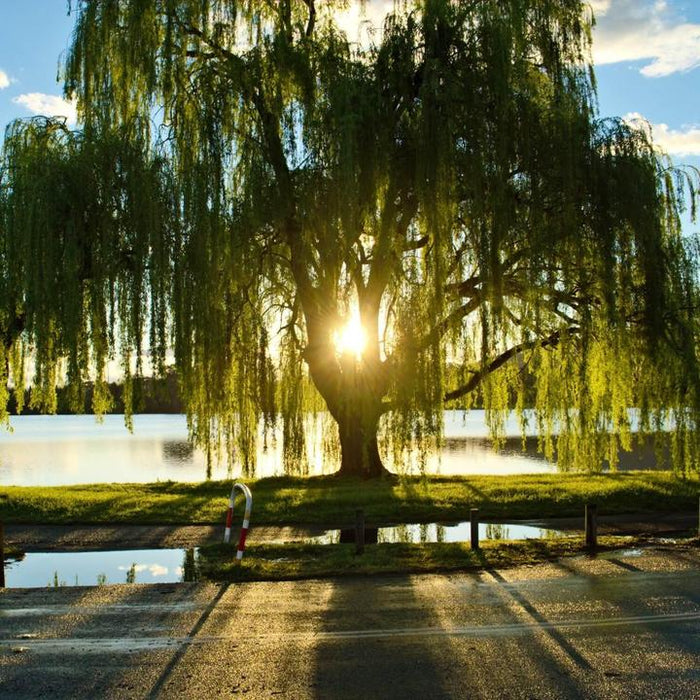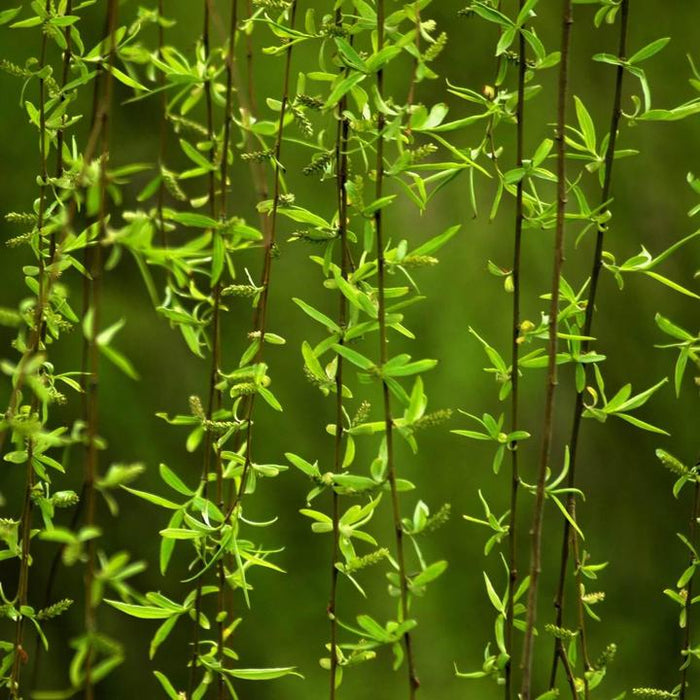
Weeping Willow
A classic and calming beauty that is perfect for your any large landscape!
--
The Green Weeping Willow flaunts its classic and elegant beauty with its dangling arched branches and calming appearance. It has a long, slender and light green foliage, and can preferable grow somewhere next to water. Its gorgeous round canopy can serve as a nesting place for a variety of birds and can bear food for beavers, deers and rabbits. This calming tree needs uninterrupted and unmodified sunlight for at least four hours per day. The beautiful yellowish catkins of the Green Weeping Willow appears during late Sping or Winter. During the Fall, its light green leaves would change its color and becomes yellow. This willow tree grows fast and can reach up to 30 to 50 feet, with a width of 30 to 40 feet. It can generally adapt to any soil composition, but to achieve best results, make sure the soil is moist and well-drained. The perfect place to plant the Weeping Willow is near a stream or pond.
- Classic and Elegant Tree!
- Beautiful Yellow Flowers in Late Spring and Winter
- Loves Full Sun
Growing Zones: 4,5,6,7,8,9,10

Where to Buy a Weeping Willow Tree for Sale
Weeping willow trees are fast-growing, beautiful trees that make a great addition to any garden. But before you buy a weeping willow, it’s important to understand their benefits, where to find them for sale, and the prices and planting requirements associated with these trees. This article will cover all the details you’ll need to consider when buying a weeping willow tree.
Benefits of Weeping Willow Trees
Weeping willow trees have a number of benefits. They are fast-growing, so if you're in a hurry to get a nice shady area, a weeping willow is a great choice. They also give you a lot of privacy and provide a great focal point in any garden. These trees create their own microclimate which can attract birds and other wildlife, adding beauty to your outdoor space.
The branches of a weeping willow tree grow out in large arcs, which can provide year-round visual interest in a garden. They look great when draped in string lights for nighttime entertaining. Finally, weeping willow trees are generally easy to care for, as long as their needs are met.
Where to Find Weeping Willow Trees for Sale
Weeping willows can often be found at local nurseries or garden centers. If you live in an area with a larger garden center, they may have an entire section devoted to different varieties of weeping willows. You can also purchase these trees online from nurseries that specialize in selling trees.
If you’re looking for an especially rare variety of weeping willow tree, you may be able to find one on an online marketplace such as eBay or Etsy. Before you buy one, make sure to read the description provided in full and ask any questions you have prior to making your purchase.
Different Types of Weeping Willow Trees

Weeping willows come in a range of sizes and shapes. The most popular types are the pendula or “weeping” variety, which have large, drooping branches and lush foliage. Then there’s the standard or “upright” variety, which has long straight branches and dark green leaves.
Other varieties include the cascading or “pendula" type, which has cascading branches that hang down; and the obtusa or “bushy” type, which has dense foliage along with multiple trunks and stems. In addition, each variety also has different colors and textures of bark.
Prices of Weeping Willow Trees
The price of a weeping willow tree varies depending on the type, size, and age of the tree. Smaller specimens may cost less than $10 while larger, older specimens can cost upwards of $100. The price also depends on whether you want a potted or bare-root tree.
It’s important to know that with any tree purchase, you also need to factor in the cost of delivery and planting supplies. You should also consider the overall cost of maintaining a weeping willow tree when purchasing one. These factors should all be taken into account before making a purchase.
Planting and Care Tips for Weeping Willow Trees
Once you’ve chosen the right weeping willow tree for your garden and purchased it, it’s time to think about how to plant it correctly. Weeping willows need plenty of water and mulch to help retain moisture and keep the roots healthy. Choose an area with well-draining soil and plenty of sunlight for best results.
Watering your weeping willow tree regularly is important - but don’t overdo it! Mature weeping willow trees can require up to 30 gallons of water per week during hot summer months. Pruning is also necessary on a regular basis to keep your tree healthy and looking great.
Where to Find Expert Advice on Buying a Weeping Willow Tree
When buying a weeping willow tree, it can be beneficial to seek out expert advice before making your purchase. The best place to start is by asking your local nursery or garden center for advice on what type of weeping willow tree is best suited to your garden and their tips on properly planting it.
You can also find forums and discussion sites online dedicated to helping gardeners get advice on buying a weeping willow tree. Reading up on gardening tips online is also an excellent way to get first-hand knowledge from seasoned professionals.
How to Choose the Right Size Weeping Willow Tree for Your Garden
When choosing the size of weeping willow tree for your garden, it’s important to keep in mind how much space you have available and what kind of landscape design you’re looking for. The size of the tree should match the overall scale of the landscape—a small tree in a large garden won’t look right, so it’s best to opt for a larger size.
Additionally, it’s important to consider how mature the tree is when you buy it—smaller trees will require more time and effort to get them established in your garden, but they may be more cost effective. On the other hand, larger trees may require less maintenance but they can be more difficult and expensive to purchase.
Potential Problems with Buying a Weeping Willow Tree
When purchasing a weeping willow tree, it’s important to be aware of potential problems that may arise during delivery or installation. For example, very tall trees may require specialized moving equipment and expertise that you may not possess.
Other potential problems can include incorrect soil type or drainage issues that affect plant growth; damage caused by weather or pests during transport; or incorrect planting that causes root rot or other problems due to incorrect spacing between plants.
Common Diseases and Pests Affecting Weeping Willows
Weeping willows are susceptible to various diseases such as powdery mildew or canker disease caused by fungi. They can also be attacked by pests such as aphids or caterpillars. It’s best practice to inspect your trees regularly for signs of pests or disease.
If you spot any symptoms early on, it’s best to take action as soon as possible. This could include using insecticides or fungicides to stop the spread of pests or diseases; or pruning affected branches to reduce the spread.
Buying a weeping willow tree is an investment that requires research and proper care. By following the tips in this article, you’ll be sure to choose the right tree for your garden and give it the best chance at thriving in your outdoor space!


